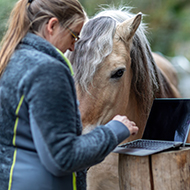The Importance of Identification
The move comes after the charity took in a seemingly healthy and well cared for pony found tied to a fence in Buckinghamshire in January. Because the pony is not microchipped or freezemarked there has unfortunately been no means of accurately identifying him and tracing his owner.
The 13.2hh cob gelding was originally found by the RSPCA who took him to The Blue Cross equine centre in Burford. Following an unsuccessful appeal for the owner to come forward he was eventually signed over to The Blue Cross. Named Hugo by centre staff, he is being carefully assessed and is in good condition and is used to being handled. It is hoped that he will eventually be suitable for rehoming via the popular Blue Cross loan scheme.
Vicki Alford, equine centre manager at The Blue Cross, Burford said: "We are unsure if it was intentional, accidental or an unfortunate misdeed that this pony was so sadly abandoned but it is highly likely that someone is devastated by his disappearance. This could have been so easily prevented had the pony been clearly and permanently identified with a microchip or freezemark, which would have enabled the owner to be traced quickly and efficiently."
All horses and ponies belonging to The Blue Cross are micro-chipped as a preferred method of permanent identification. This is in addition to complying with Horse Passport legislation, whereby all equines have a unique identification document. The charity also advises that keepers of horses and ponies should employ suitable standards of security to protect the animals from misadventure and theft. The use of security signs and marks on stables, fences and rugs, indicating that the horses are microchipped or freezemarked, are good deterrents and should form part of the security plan.



 With Strangles Awareness Week just around the corner (5-11 May), vets are being encouraged to share a survey about the disease with their horse-owning clients.
With Strangles Awareness Week just around the corner (5-11 May), vets are being encouraged to share a survey about the disease with their horse-owning clients.